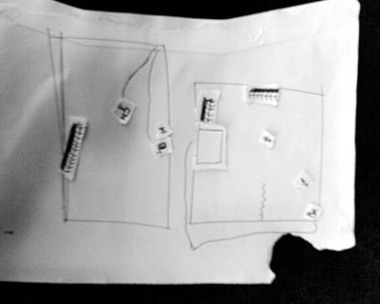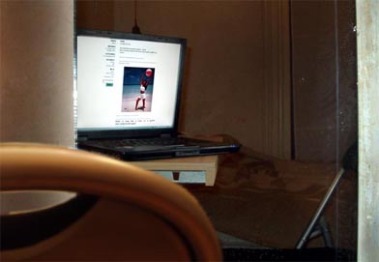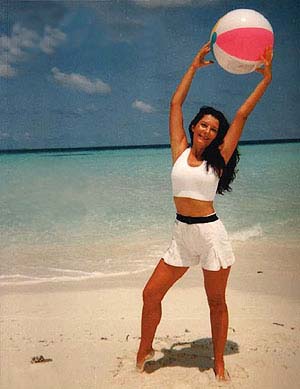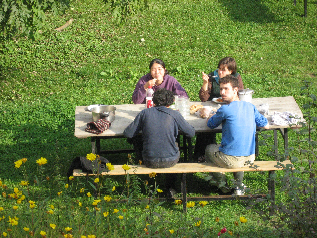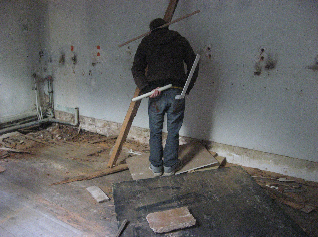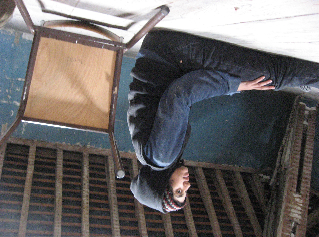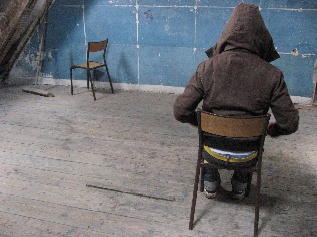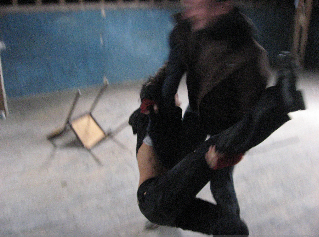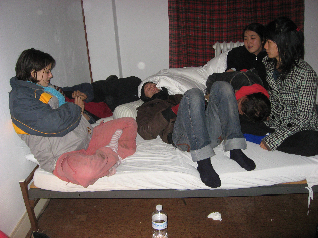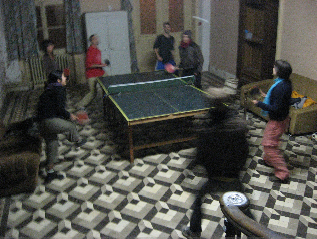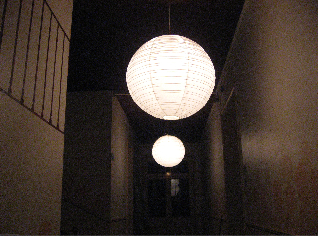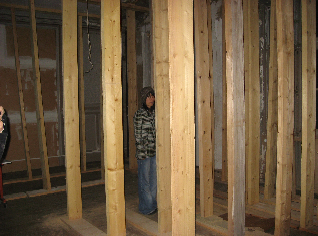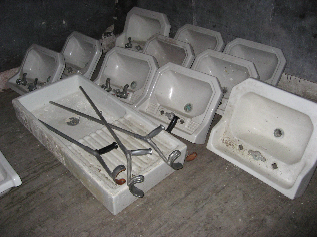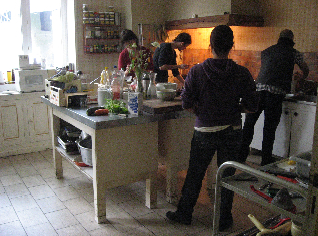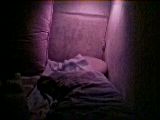I am taking back my remark that the blog is an autonomous work of art (though in some cases it is). Right now I would say: it is our rehearsal studio for thought.
blogs and pieces
December 3, 2007Interesting issue there you mentioned about the blog hyper-framing your experience of the actual performance. I am thinking of blogs not as secondary disciplines but as autonomous art works. Seems like you cannot take things back or control when making art. Open it all up and see what it produces. Have to also admit that the more I open it all up, the less I could tell you anything about my criteria on anything. Is there such a thing as something good and something not good? If work is very imposing, then I am usually having a bad time in the theater. But if work is open and allowing for different perspectives, it makes me rather drop the parameters of good and bad, and I respect it as something that produces. The more we work with creative processes and shared thought, the more my opinions dissolve. I am acknowledging activities, other people’s and my own, as patterns in time, something to do because something probably needs to be done. Opening towards process and multiple perspectives really can be very disorienting. But again, why should we hold back. Let’s disorient then. Between being born and dying… what will be done… writing blogs with others, performing dance pieces with others, is it worthwhile, is this or anything else worthwhile, is reading blogs and attending to dance pieces worthwhile, is sleeping eating and earning money worthwhile, is any type of frame worthwhile, how could you avoid the frame, any frame …
the Wet rig grits? ha
December 2, 2007Someone started a post who knows when, with the title “What is the trigger?”. I think it was even while we were still at PAF. Anyways, I see it there everytime I log in to the site, a draft waiting to be written, to be published… or maybe it’s just my want (mijn trek). So here it is. Maybe this long lost line is the trigger:
I am in a rehearsal. I take a position as a maker. I tell people what to do. People
I sometimes wonder if it was me who wrote it… but I’m not really sure
blogs/frames
December 2, 2007last week I went to Het Veem to see Diego Gil’s work in progress. he is working together with Igor Dobricic in a new piece, and they have also a blog for it (www.aboutfalling.wordpress.com). the thing is that when the performance started I realized for the first time that as much as the idea of publishing blog, with contents from your creative process, relates to opening and sharing this process, it also becomes a frame for the performance. might seem quite obvious, but I didn’t realize until then. so as much as I like the idea of making your process available to the general audience, I started wondering how much do you need to keep this into account when writing. o sea, if the writing should also avoid certain things that might frame the work too much, or give out things, etc, etc… I think it’s a tricky issue, because limiting the possible content of the blog contradicts the idea of really opening the process, and at the same time makes it weaker as a tool for (self/group)reflection. and I could even think that the nature of the creative process (and thus in some way, the nature of the blog) don’t really narrow things down but open them up. but still I had the experience at Diego’s presentation of somehow ‘knowing’ more than I would have liked to… which is a bit of the same feeling I had this week when watching the pieces in the Danstheater (Yurie, Noha, Lea)… oh, fuck, is it possible or even important to go to see pieces completely blank? or how to deal with all that previous information, how not to let them get in the way at least during the time of the performance.
niupost18112007
November 19, 2007Today I woke up, prepared some torrejas (it’s just bread wet in egg, sugar and milk, and sort of fried in butter) like my mother used to cook long time ago on Sundays. Desalmuerzo = brunch. Later I went to see the Krisztina de Châtel performances, with Tina’s piece in it. I couldn’t stop thinking, I couldn’t really let go and enjoy, or at least experience. Don’t know if it was because of me or because of the performance. During the last one I just took out my PDA and started writing some of the stuff that follows.
I feel like I’m back at the beginning.I’m not so excited about theaterdancepieces, it’s not very easy to name theaterdanceartists that I am really excited about, or theaterdancepieces that I remember… or yes? most of the time is more about friends and artists I know closely, to whose work I have a closeness that I don’t have to other well known artists, legitimated artists…I remember when I started studying dance and assisting a choreographer, participating in rehearsals and giving opinions on what I saw before having ever seen a dance piece, at that time I was so much more excited about processess than about pieces. And now I feel a bit like that again. This last couple of weeks I tried to go and see some performances, but my motivation is not completely there. I find it easier to stay at home and watch a movie, write and read things on the internet (which in my life is also overpowering books at the moment), etc… I am more excited about rehearsals than about performances. And of course, the workshop with Nora, and reading her writings and a bit of discussion with her, and trying to look at things in a somehow more global way (is that a good way to put it? to include a lot more things and environments and people and events in the idea of a dancetheaterpiece), all of this is also bringing my focus more on the process.The scary thing, then, is if it can stay communicative, if it can be shared with more people than just the researchersperformers. In that sense, the blog strategy seems great. I’m very excited about it and looking forward to start using it, both in this process and in others… Why do a performance then? This doesn’t have to have a solutionanswer, anyways… Maybe the experience of the performance is worth it if it can trigger energy, if it can inspire, o sea, if people that go to a performance leave the performance with a libido for something: writing, doing, shouting, moving, making love… sorry if this is getting too cheesy.
On my way back home I took some pictures in the Vondelpark; I couldn’t stop complaining about the dutch weather and the fact that it was already dark at 17 hs.
wow
November 7, 2007Who the fuck found this picture – great.
Now you know what to do if you ever need to uplift your career.
ththis is long like a train or a giraffe neck. external:self:space:
October 28, 2007Ok so this is a dialogue I am having with myself and in relation to a book i have been reading called “Queer Phenomenology” by Sara Ahmed where she analyses the concept of ‘orientation’ I will quote her and ramble on, please accept these unfinished thoughts its a bit freaky to make them public but i am looking for help.
I was in New York City and now i am in Western Massachusetts. i will be in Amsterdam soon. I am busy with the problem of self and the external: is the external is self. i do not inhabit new places, new cities, new york city. I am inhabited by them. my internal space is changed when i move around.
“the object is not reducible to itself, which means it does not ‘have’ an ‘itself’ that is apart from its contact with others. The actions performed on the object (as well as with the object) shape the object. The object in turn affects what we do.”
I am reading this and I am thinking about the body – the body as an object. How useful can it be to consider the body as an object? I don’t mean to deny the person-ness of a body, I do feel it to be important to see the subjectivity of a body. Is that where movement lies? Is movement its subjectivity?
I would like to refer to Foucoult whose name i can’t spell and with the disclaimer that i know very little about the guy’s ideas and i hope that this is ok. I am not about to go reading books by the dude at this point because a) i don’t feel like it b) it would be dangerous for my physical practise and the work i am making and c) at this point i don’t really care what he says I am trying to figure out what is useful for me and what my own questions and interests are. so there. And because I think that there is some line of investigation into the readerly and writerly capabilities of the body in his writing. The idea that power is inscribed onto the body. But is power tangible – something to be given or taken? What if we think of power as a process, in evershifting relationships – something we talked about at PAF. ?
<But she does not know what she smells here. It is confusing her. She turns to another memory>
‘The Performance of tHe SElf in Everyday life.’ I only read a bit of that book – but what of the idea that we only ever perform our ‘selves’. There is no authentic self. Or perhaps there is a self but it is not separate to, in a vacuum, in isolation from its relationships to others, to the external, and that it appears differently depending on its orientation and the orientations which approach it/ tend towards it/ / ?
< This brings me to the question of authenticity (ouch) which i am gonna post a bit later with guest appearances from Lea and a bunch of books on authentic movement (ouch) which i happen to have found in the bookshelf of Velvet’s mother’s house, a condo on a hill in the countryside of Western Mass. – ! >
But for now to continue with the ideas of spaces and how they ‘extend’ the body…
Background quotes:
“The nearness of some objects, their availability within my bodily horizon is not casual – i do not just find them there. “rather, the nearness of such objects is a sign of an orientation I have already taken towards the world as an orientation that shapes what we call, inadequately, “character”….Bodies tend towards some objects more than others given their tendencies. These tendencies are are not originary but instead are the effects of the repetition of the “tending toward.” – …. bodies come to ‘have’ certain orientations over time and they come to be shaped by taking some directions rather than others and towards some objects rather than others.”
The field of what this or that body does do, also defines a field of inaction, of actions that are possible but they are not taken up, or even actions that are not possible because of what has been taken up. Such histories of action or “take up” shape the bodily horizon of bodies. Spaces are not only inhabited by bodies that ‘do things’, but what bodies ‘do’ leads them to inhabit some spaces more than others. If spaces extend bodies, the we could say that spaces also extend the shape of the bodies that ‘tend; to inhabit them. “What bodies ‘do’ leads them to inhabit some spaces more than others.”
Sara Ahmed asserts that phenomenology exposes the “sedimentation” of history in the repetition of bodily action… and so “what bodies “tend to do” are effects of histories rather than being originary.
So /. BUT. Can we short-circuit this ‘sedimentation’ ? Is this what happens when the body is challenged by external demands, when it is trying to extend itself, it is becoming, or instead of being it is becoming something else, a moving toward something? This seems related to how I have been trying to work physically (thanks to advice from Katarina) – — — the intensity of being and the necessity of becoming more. i am not just simply happening. The possibilities which open up when demands are placed, when the body is in conflict, when the body is extending itself. The new directions that open up as a deviation from the path of standard orientation occurs, when we take different facings, when we tend towards different bodily inhabitations.
i am not suggesting to find an answer or even that any of this is very clever, just that I’m desperately trying to relate my readings/ theory with the physical practise and experience that I am having when I work. Of course there is a difference between moving for therapy/abandon/pleasure/release… and the (also satisfying) demands of working physically with constructed challenges – this alone makes it tend toward art not therapy. I do not expect there to be a difference between theory and practice.
so, thanks you for reading if you got this far. be a slut with your thoughts! i will provide coffee… xn
virtual relation
October 18, 2007I found the idea of the virtual projected coexisting neighbor very interesting. Wondering how such a relation would be influential to the whole situation? Try it. Contact Dave (maybe through dance unlimited) to help you with live feed!
skins
October 18, 2007I thought to introduce the concept of skins as surfaces. Can coexistence be a way of interacting through intensities that run over surfaces (body skins, architectural surfaces, textures,…) instead of dealing with psychological depth or the depth of the flesh… Can we just think of skins? What can resonate between skins? Could try to simply work with rhythms and timings, poly-rhythms (coexistence of different rhythms) and multiplicities of timings or durations. Could coexistence as practice be away of emptying in regard to psychology and depth so that only intensive surfaces and rhythms stay over? People had mentioned before that timing was key…
October 17, 2007
hello everyone,
regarding pole’s thoughts about next week:
one of the interesting aspects for me about co-existence is the practise of it, so I would prefer to do it everyday if possible
and
i think somehow a longer duration could be quite vital in order for a particular mindset to emerge (for the observed in particular i am thinking of) where one sees oneself as part of the space, co-existing with all elements including those osberving, objects. allowing a longer time allows things to happen, to settle, for nothing to happen. it could be difficult i imagine in half an hour to displace/interfere with/question/expose the often polarised relationship established between audience and performer. but, then again maybe 30 minutes could be fine. i think it would be good to leave the time frame regarding the lunch lecture open for the first half of the week. perhaps through the practising of it we will get a sense of how much time we need.
ok, enough for now, ciao xx
regarding proposal
October 16, 2007Sounds great! That’s a really nice idea to keep going with the group dynamics and see what can come from it. Maybe using the atelier week to dive deep into the coexistence idea, repeat it many times so that something interesting can appear from it eventually? Let’s go
proposal
October 15, 2007bonjour,
i would like to propose an activity to present at the friday lunch lecture next week. it would be good to keep the group momentum rolling, and continue to work on the idea of co-existence.
proposed work model:
– two observers, two observed.
– different spaces for each ‘session’.
– work in the afternoon time, from 1:45-4:45.
– divide the time in two in order to switch roles and spaces.
proposed performance situation:
– two different spaces
– split the our group in half, two co-existors in each space.
– split the audience in half, one group at each performance site, and to consider how we want to place the audience
– in each space, project the other site. so in each performance site we have two actual co-existors and two virtual ones.
– these two events are happening simultaneously.
– one hour long
one thing i don’t know is how to make the live feed of projection??
so i put this out in to the ether… what do you think? do you have another suggestion? do you think working as a group stinks and you would rather do your own thing?
tot later, hugs and kisses and happy holiday romances to you
?
October 13, 2007Could we consider the round-table-ping-pong and the chair-chain-game coexistences and emergent compositions? How did the fact that we named this thursday session a coexistence change people’s behavior? Could rupture and difference produce interesting relations?
space observation
October 11, 2007I was wondering if what we had been doing yesterday was an astronomical activity?
observing the observer
October 11, 2007What does the very act of observing do with any activity? With space? What does observing an observer who also observes an observer does with space? How far does the space we are in reach? Can it be endlessly extended through chains and networks of observers? If there is nobody in a room with us, does something still observe what we are doing? By observing an observer, can we perceive the perception of that observer? Is that a doubling of perception?
?
October 10, 2007Could we consider this workshop as being a semi-guided, semi-emerging collective choreography?
Could we consider the movements that happen between all the people in the house a self-composing choreography?
a list…
October 10, 20071. What is dance, what is movement?
2. Why do you dance?
3. What is choreography?
4. What is a choreographer? (guide, frame provider, initiator, organisor, …)
5. What kind of politics would you like to practice? (bottom up, top down, complex networks, clear hierarchies…)
6. What do you want to do?
7. What do you want to be?
8. How do you want to do it?
9. Do you care about the rest of the world?
10. How do you set up a frame for research?
11. How do research and performance making correspond, relate to each other?
12. What is the main sense organ you are working with?
13. Do you care about the audience?
14. What does caring about them or not giving a shit really mean to you?
15. Should work be repeatable, set, conserved, or ever changing?
16. Technique? Do you have a physical practice? Is that static or does that change with any new project you do? How do you invite others into that practice? Should training be the same movement technique you want to use for your performance work or should it be independent?
17. What can a body do?
18. What can art do?
19. What can you do?
20. How do you compose?
21. How do you disorient yourself?
22. How do you disorient an audience?
23. How do you relate to power and knowledge with audiences, with co-creators?
24. Do you like the work you are making? Would you like to go see your own work?
some of yesterday’s (tuesday) locations
October 10, 2007yesterday morning’s yoga studio
view from yoga studio
garage
garden
multi-ball-multi-player-rotating-group-ping-pong
(including language and object interventions)
linkis
October 9, 2007here’s a few articles on the work of James Turrell and Olaffur Eliasson, whose installations are often based just on proposing a space that triggers questions about perception… they work a lot with light, though not necessarily with artificial lights
http://www.orbit.zkm.de/?q=node/311
http://www.orbit.zkm.de/?q=node/309
morning questions wake me up
October 9, 2007how do i relate to a space?
what is the difference between a space and a place?
can a space suggest a physicality?
I feel like I have to fit myself into a space and relate to it. Can the space fit into me and relate to me?
what is really making bodies move?
October 8, 2007I am in a rehearsal. I take a position as a maker. There are dancers (movers) who came to the rehearsal to collerborate with me. I give them some tasks to improvise to find movement materials. They start to move their body and work on the tasks. I observe them in silence. I start to wonder what is making their bodies move. What is really triggering their movements? is it from the tasks? is it from them? is it from co-incident? is it from somethingelse?
October 8, 2007
Choreography -literally “dance-writing”, also known as “dance composition”
What is “Dance”?
How can we define “Dance”?
Are we making “Dance” pieces?
task
October 8, 2007Shift space all the time. For each new activity, choose another space. (since there is plenty of choice here)
task
October 8, 2007HUMAN BEINGS HAVE BODIES. Academics of every variety, so often caught up in the life of the mind, find that simple truth altogether too easy to forget. Imagine working late into the night, hotly pursuing another bit of perfect prose. But now let there be a power outage and, in the absence of electric light or the pale glow of the computer screen, imagine how we grope and fumble to find our briefcase, locate the door, and exit the building. In such circumstances, the body returns. Whenever we are unexpectedly forced to move about in the dark, we are forciblyreacquainted with our bodily sense of space.
so the task i propose: 1 person (or more) volunteer to blindfold themselves and the rest watches. It is an exercise in observing how the body relates to space. I am interested to see how a particular physicality emerges in relation to the space he/she locates themself in, and conditions of being blindfolded and having an audience.
October 8, 2007
i dare anybody to make a piece full of all the wrong decisions, all the things you thought were great for a moment (what were you drinking that night anyway) but then grow out of immediately. these are the stepping stones. make a piece full of stepping stones that you refuse to let go of. hold on to them, get constipated. stop questioning and don’t take the advice that you know you need to hear and do not subvert yourself. i wonder what would happen just maybe that i have to do this so that i might keep asking questions because tonight i’m tired and can’t really hear any of this anymore
quote from unknown artist
October 8, 2007From the beginning, I have always tackled my works with the desire to see what they could teach me, what they could help me to discover. From all the universal values that they have enabled me to appreciate, one idea stands out above the others – “relations”, which are more important for me than the elements themselves. Artists are generally preoccupied by elements already situated in a well-defined space, while in reality elements should only serve to reveal the existence of countless “relations”, not only in space but also in time.
relationality
October 8, 2007Call the openness of an interaction to being affected by something new in a way that qualitatively changes its dynamic nature relationality. Relationality is a global excess of belonging-together enabled by but not reducible to the bare fact of having objectively come together. Relationality is the potential for singular effects of qualitative change to occur in excess over or as a supplement to objective interactions. (Brian Massumi)
choreography
October 8, 2007Choreography (literally “dance-writing”, also known as “dance composition”), is the art of making structures in which movement occurs. The term composition may also refer to the navigation or connection of these movement structures. The resulting movement structure may also be referred to as the choreography.
Relational theory
October 8, 2007In physics and philosophy, a relational theory is a framework to understand reality or a physical system in such a way that the position and other properties of the objects are only meaningful relative to other objects. In a relational theory, space does not exist unless there are objects in it. The relational view proposes that space is contained in objects and that an object represents within it self relationships to other objects. Space can be defined through the relations among the objects that it contains considering their variations through time. The alternative is an absolute theory in which the space exists independently of any objects that can be immersed in it.
task
October 8, 2007group chooses a space. in silence. one person at a time ‘enters’ the space to hold a stillness. ‘entering’ means functional. allow this to be seen for some moments. person leaves space. next person enters. a continual rotation for a 30 – 45 minutes. some overlap of people in the psace may occur. in how many different ways can we see this space, can we get to point of exaustion.
workshop
October 8, 2007Radical frames: to radically stretch, expand, burst or question choreographic and production frames, creative frames. How can we create working contexts that allow for risk? How can we shift our own politics of interacting with people to create new environments for new forms? How can we navigate given structures to allow for difference?
Can we radically stretch the frames of time, space, material, audience, composition, group politics?
1. time: we can work at any time of the day
2. space: we can work anywhere (inside, outside, drift, walk, small space, large
space, kitchen, bedroom, toilet)
3. material: anything we want to call a dance can be a dance: walk, stand, sit, lie,
run, actions, and anything as crazy and virtuoso as you like, as long as it can be
seen in relation to other things
4. audience: how many audience perspectives and set ups can we invent?
5. composition: can the work compose itself rather than composition being imposed?
6. social structures and group politics: how do we want to organize collective
bodies, dancers, audiences, ourselves in relation to them? What political models
interest us?
task: no talk space intervention
October 8, 2007Intervention. The 8 of us have the chance to create an intervention about space whenever they want. Rules: each one of the 8 works independently. The intervention should happens in a moment the group is together. The theme is “change the space”: i.e:make a space looks different, convey the attention of the group towards a particular area, find a phisicality that can fit or affect the space, find a way to bring the group in a “performative” area trough a path… Each intervention can lasts maximum 5 minutes. There`s NO gonna be verbal talk about the intervention, Comments and questions are allowed just trough the log. These 8 intervention can happen from the midnight of today (monday) to the midnight of tomorrow (tuesday).
8 times, 5 minutes of space. Through the repetition and silence: dropping, one after the other outside the group space, in another space.
in articulating these questions i committ to asking them
October 8, 2007now can i forget about them
bjork
October 8, 2007How do i trust in the intuition of my own process. If i follow my desire (?) and try and be as selfish as possible, does that help to make me clear about my questions? What happens if i just commit to staying interested in how i am going about my process and trust that it will transgress into something more contextualised?
October 8, 2007
questions on how to post questions on command.
what are my important questions now?
why is it so cold?
how to frame the performers mind for the process that is coming up?
conclusions?
im trying to make work that i like!
i like work that travels
that makes a journey from here to hell and back.
complications though occur
for the moment I’m occupied with letting my self be the feeder of the monster coming out of my initial idea.
how to take my hands off it in time to not suffocate it. i want to let it breath the air and prosper from my nourishment?
and there comes the question of framing the monster for a respectful venue.
not taming it but framing the monster.
October 8, 2007
yeah so i was having this conversation the other day, can’t remember who we were talking about (Kristeva? ), er i don’t really care the point is that we were discussing how the question ‘who am I?’ is much less interesting than the question ‘where am I?’ or ‘How do I act, and what acts in me when I act?’. The focus becomes more about relationships or engagement, and takes away the idea of a central, fixed ‘I’. Where am I? Can I possibly resist asking Who? Can I really give identity or self-definition over to the relationship with my environemnt? What then becomes the border between the inner and outer world (?) aach its a dirty question.
October 8, 2007
Task Performance Measures
It has been suggested that task performance measures can be used as objective corroborative indicators of presence. Though it is generally assumed that higher levels of presence are associated with better task performance, the exact relation between presence and task performance remains unclear. Also, characteristics of the user such as ability and motivation will influence task performance. Task performance measures are only applicable in media environments where there is a clear task that should be performed.
Completion Time and Error RateThe time taken to complete a task and the number of errors made in that task are the most classic ways of measuring task performance.Number of ActionsInstead of measuring the time taken to complete a task, it is also possible to count the number of actions or steps that is needed to complete a task.Secondary Task PerformancePerformance on a secondary task can serve as a measure for the amount of effort allocated to the primary task. The more effort is dedicated to the primary task, the more performance on the secondary task will decrease. A similar argument can be made in the case of presence: if more attention is allocated to the mediated environment, performance on a secondary task will decrease. Reaction times or error rates can be used as secondary task performance measures (IJsselsteijn, 2004),TransferPerformance can be measured by the degree to which a skill which is learned or practised in a Virtual Environment is transferred to a real-world situation.
still looking for answers
October 8, 2007I feel lucky to study the world and have curiosity. I enjoy experiencing the world through the lenses time./.space./.body./.movement. If this is my practise, then this is my practise. this can move me through a day, in privacy. So what extends from this, what is it the drives that practice towards something that becomes visible. i.e. performance. why do we do it?
sorry
October 8, 2007after that little tour I want to invite someone to experience that space, one of any of them. in the darkness it was a lot of fun, it made my heart beat fast and my breath rush.
there is a space in between us all writing that is a different space from the two spaces between all our writings, and the little space in between each writing
Definitions
October 8, 2007
- Main Entry:
- 1rad·i·cal

- Pronunciation:
- \ˈra-di-kəl\
- Function:
- adjective
- Etymology:
- Middle English, from Late Latin radicalis, from Latin radic-, radix root — more at root
- Date:
- 14th century
1: of, relating to, or proceeding from a root: as a (1): of or growing from the root of a plant <radical tubers> (2): growing from the base of a stem, from a rootlike stem, or from a stem that does not rise above the ground <radical leaves> b: of, relating to, or constituting a linguistic root c: of or relating to a mathematical root d: designed to remove the root of a disease or all diseased and potentially diseased tissue <radical surgery> <radical mastectomy>2: of or relating to the origin : fundamental3 a: marked by a considerable departure from the usual or traditional : extreme b: tending or disposed to make extreme changes in existing views, habits, conditions, or institutions c: of, relating to, or constituting a political group associated with views, practices, and policies of extreme change d: advocating extreme measures to retain or restore a political state of affairs <the radical right>4slang : excellent, cool
— rad·i·cal·ness noun
- Main Entry:
- 1frame

- Pronunciation:
- \ˈfrām\
- Function:
- verb
- Inflected Form(s):
- framed; fram·ing
- Etymology:
- Middle English, to benefit, construct, from Old English framian to benefit, make progress; akin to Old Norse fram forward, Old English fram from
- Date:
- 14th century
transitive verb1: to construct by fitting and uniting the parts of the skeleton of (a structure)2 a: plan, contrive <framed a new method of achieving their purpose> b: shape, construct c: to give expression to : formulate d: to draw up (as a document)3 a: to devise falsely (as a criminal charge) b: to contrive the evidence against (an innocent person) so that a verdict of guilty is assured c: fix 7b4: to fit or adjust especially to something or for an end : arrange5obsolete : produce6: to enclose in a frame; also : to enclose as if in a frameintransitive verb1archaic : proceed, go2obsolete : manage
— fram·able or frame·able  \ˈfrā-mə-bəl\ adjective
\ˈfrā-mə-bəl\ adjective
— fram·er noun
space potentiality
October 8, 2007is there a space that dosent have a potential?
how do you show the potential without illustrating it?
task
October 8, 2007Creating a chain of space observers. First person take a chair and place yourself in any space fo your choice, observing the space from any perspective of your choice. Second person take a chair and place yourself as an observer in relation to first person, observing space and that person as part of space. 3rd to 8th person continue the chain in the same way. You can choose any proximity or distance. Sit for as long as you wish. When you wish to move (at any point and independently from the others), take your chair and add yourself to the end of the chain. As a group, travel that way through the building for as long as you wish.
cooking
October 8, 2007Cooking with 8 people for 8 people without having made a plan seems to be a good exercise on emergent composition.
excursion
October 8, 2007Nightly drift through the labyrinth of the entire building, ended up out in the garden for a talk. Realized that the building itself has such a powerful presence, hardly needed to add anything. How could we create parcours through space, nomadic audiences, guided but not imposed. Could we choreograph simply how we look at or perceive space. Very dusty lungs from old stagnant air. Many strange discoveries.
